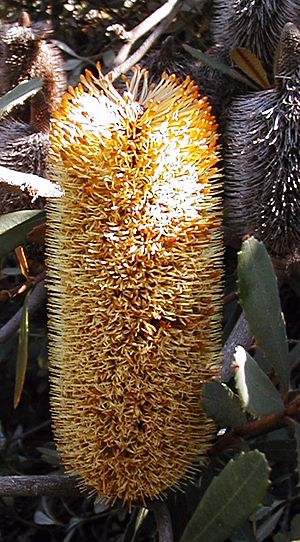Glasshouse banksia facts for kids
Quick facts for kids Glasshouse banksia |
|
|---|---|
 |
|
| In Maranoa Gardens | |
| Scientific classification | |
| Genus: |
Banksia
|
| Species: |
conferta
|
| Synonyms | |
|
|
The Banksia conferta, also known as the glasshouse banksia, is a type of shrub. It grows only in eastern Australia. This plant has rough bark on its trunk. Its leaves grow in circles, and its yellow flowers are packed tightly together. After flowering, it forms many seed pods.
Contents
What Does the Glasshouse Banksia Look Like?
The glasshouse banksia is a shrub that usually grows up to 4 meters (about 13 feet) tall. Unlike some other plants, it does not have a special woody swelling called a lignotuber. This means it can't regrow from its base if it burns down.
Its trunk has rough, grey bark that looks like a puzzle. The younger stems can be orange, red, or brown and are hairy at first.
Leaves and Flowers
The leaves of this banksia grow in groups called whorls, which means they circle around the stem. They are shaped like an oval or an egg, wider at one end and narrower at the other. Each leaf is about 3.5 to 12 centimeters (1.4 to 4.7 inches) long and 0.7 to 4 centimeters (0.3 to 1.6 inches) wide. Their edges curve downwards and sometimes have small teeth.
The flowers grow very close together on a spike. This spike is like a long cylinder, about 7 to 19 centimeters (2.8 to 7.5 inches) long. At the bottom of the spike are special leaves called bracts, which are about 1 to 2 centimeters (0.4 to 0.8 inches) long.
When the flowers are still buds, they are yellowish-green to pinkish-brown. As they open, they turn a bright golden yellow. Each flower has a part called a perianth, which is about 2 to 2.6 centimeters (0.8 to 1 inch) long. The part that collects pollen, called the pistil, is also about 2.2 to 2.6 centimeters long and is slightly curved.
Life Cycle and Seed Pods
The glasshouse banksia usually flowers from late April to July. After the flowers fade, they form narrow, oval-shaped seed pods called follicles. These pods are about 0.8 to 1.5 centimeters (0.3 to 0.6 inches) long.
Often, more than 100 seed pods can form on a single flower spike. The old flower parts stay around the pods. These seed pods usually stay closed until the plant is burned. This is different from the Coast banksia, which has less crowded flowers and opens its pods without fire.
How the Glasshouse Banksia Got Its Name
The Banksia conferta was first officially described in 1981 by a scientist named Alex George. He found the plant near Mount Tibrogargan in the Glass House Mountains National Park in 1975.
The second part of its scientific name, conferta, comes from a Latin word. It means "crowded." This name was chosen because the flowers grow very close together on the spike.
Scientists sometimes change how they classify plants. In 1996, another scientist named Kevin Thiele decided that a type of banksia that used to be considered a part of Banksia conferta was actually its own separate species. This new species is now called Banksia penicillata.
Where Does the Glasshouse Banksia Live?
This banksia plant is found in southern Queensland, Australia. It grows in places like the Lamington Plateau and the Glass House Mountains. It likes to grow on steep, rocky slopes in areas with scrub and open bushland.
A specific group of Banksia conferta also lives in the Coorabakh National Park in New South Wales. This group is listed as "critically endangered." This means it is in great danger of disappearing and needs special protection to survive.

